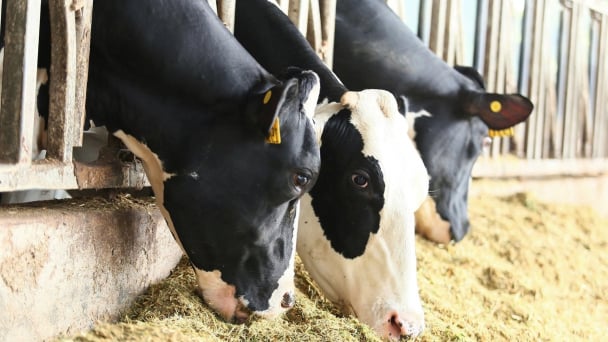August 11, 2025 | 23:25 GMT +7
August 11, 2025 | 23:25 GMT +7
Hotline: 0913.378.918
August 11, 2025 | 23:25 GMT +7
Hotline: 0913.378.918
Algae and moss, also known as harmful algae, are among the organisms that negatively affect the growth and development of rice crops in the Mekong Delta region.
According to Professor Nguyen Tho, Vice President of the Vietnam Association of Plant Protection Sciences and Vice President of the Vietnam Association for Plant Pathology, farmers typically introduce water into the rice fields six to eight days after sowing in preparation for the first fertilization. Algae and moss develop more aggressively in areas where rice cultivation occurs continuously over three seasons or intensive rice fields (seven crops over two years).

Algae and moss proliferating in rice fields. They cling to the base of the plants and compete for nutrients with rice crops. Photo: Kim Anh.
When algae and moss attach themselves to the rice stems, they limit the plants' ability to tiller and compete for essential nutrients. In low-lying areas, algae and moss thrive on the surface, hindering the growth of young rice seedlings and causing death in severe cases. Farmers must spend additional effort to replant and fertilize to promote rice growth, which further increases production costs.
Nguyen Van Cuong, a rice farmer from Dong Binh Commune, Thoi Lai District, Can Tho City, cultivates 5 hectares of autumn-winter rice. Cuong spotted large, dense patches of dark green algae and moss that began proliferating nine days after he sowed the rice seeds. Subsequently, the harmful algae gradually spread to affect over 60% of the field.
During a field visit, Cuong observed that the algae and moss had completely covered the stems and leaves of the rice plants, preventing them from performing photosynthesis. Consequently, the algae and moss gradually scorched the leaves and turned the stems brownish-purple. Additionally, they prevent the roots from developing, which can cause insufficient root formation and weaken growth potential for the rice plants. Cuong expressed growing concern over the increasing density of algae and moss on his rice fields.
Cuong identified the cause of the algae and moss bloom as a combination of hot weather, muddy soil, leftover plant debris on the field surface, and harmful microorganisms.

Nguyen Van Cuong utilizing a microbial product to eliminate algae and moss. Photo: Kim Anh.
At the recommendation of local agricultural extension officers, Cuong experimented with the Bio Lacto EM microbial product to treat the algae and moss infestation.
He applied Bio Lacto EM at a specific dosage of 5 to 10 liters per hectare, depending on the algae and moss density in the fields, to inhibit their growth—a process known to farmers as algae or moss cutting.
Three days after applying Bio Lacto EM, Cuong inspected his fields and noticed that the algae and moss patches had begun to break apart, and the water surface became clearer. Notably, the foul odor had disappeared, and the algae and moss patches began turning reddish.
After five to six days, the roots of the young rice plants began to whiten, the leaves turned green and glossy, and the plants became sturdier. The algae and moss also disintegrated and settled, contributing to the formation of mineral-rich mud and organic matter for the soil.
Cuong recently harvested his rice fields with highly promising results. Additionally, he reduced fertilizer usage by nearly 40% and pesticide application by 30%.
Cuong estimated that his average input costs without using microbial products at 1.5 to 1.6 million VND per cong (1,000 square meters). However, his total costs for the 2024 autumn-winter crop were below 1.2 million VND per cong.

The changes observed in Nguyen Van Cuong's rice fields five days after applying the Bio Lacto EM microbial product included the disintegration and color change of algae patches. The resulting water is also clearer. Photo: Kim Anh.
Notably, the yield for his autumn-winter crop in previous years averaged only 600 to 700 kilograms per cong. With the application of microbial products, this figure has increased to 850 to 900 kilograms per cong.
Microbial products helped eliminate algae and moss in the fields and improved soil quality by killing harmful bacteria, thereby allowing the rice plants to absorb fertilizers more effectively. Consequently, farmers can produce healthier rice plants with enhanced resistance during the rainy and stormy season.
“Farmers previously cultivated three crops per year on the same area of soil, which resulted in the proliferation of toxins and algae. I experimented with the microbial products to manage the algae, and I found them to be very effective. The rice exhibited strong growth, and the costs were lower. I applied the microbial product approximately 5 to 7 days after sowing, and the rice plants showed remarkable growth with robust root systems, significantly improving their surrounding environment. Results are visible 6 to 7 days after application,” Cuong shared.

At the end of the season, Nguyen Van Cuong's rice fields, which used microbial products, delivered high yields and significantly reduced production costs. Photo: Kim Anh.
Inspired by Cuong's results, other farmers in Dong Phuoc Hamlet, Dong Binh Commune, have begun exploring and experimenting with the Bio Lacto EM microbial product.
Thai Phuoc Tung, also a resident of Dong Phuoc Hamlet, recently harvested his autumn-winter crop and achieved a yield of 900 kilograms per cong during his first application of Bio Lacto EM. By the time of harvest, Tung had only used 35 kilograms of various fertilizers per cong.
Translated by Nguyen Hai Long

(VAN) AI technology is a key foundation in high-tech agricultural production, as clearly demonstrated in Nghe An province.

(VAN) Nui Chua - Phuoc Binh National Park has earned the nickname 'maternity ward' for sea turtles to lay eggs, with multiple nesting beaches.
![Sky-high reservoirs on rocky plateau: [End] Dream of covering villages](https://t.ex-cdn.com/nongnghiepmoitruong.vn/608w/files/huyenvt (e)/2025/08/08/4851-4-nongnghiep-114847.jpeg)
(VAN) For nearly two decades, Ha Giang has built 121 hanging reservoirs on the mountains, storing over 500,000 m³ of clean water and providing domestic water for more than 100,000 residents.
![Sky-high reservoirs on rocky plateau: [4] Heart of Sa Phin hamlet](https://t.ex-cdn.com/nongnghiepmoitruong.vn/608w/files/huyenvt (e)/2025/08/07/3148-3-181558_541.jpg)
(VAN) Sa Phin hanging reservoir, the first irrigation structure on the Dong Van plateau, is heart-shaped. Within that heart lies water, considering the source of life.
![Sky-high reservoirs on rocky plateau: [3] A catalyst for ecotourism development](https://t.ex-cdn.com/nongnghiepmoitruong.vn/608w/files/huyenvt (e)/2025/08/07/3722-3-101858_203.jpg)
(VAN) More than just quenching the thirst of dry areas on the rocky plateau, hanging reservoirs are now contributing to the development of ecotourism.
![Sky-high reservoirs on rocky plateau: [2] Quenching the thirst in Can Chu Phin](https://t.ex-cdn.com/nongnghiepmoitruong.vn/608w/files/huyenvt (e)/2025/08/06/4406-4-214016_602.jpg)
(VAN) For nearly two decades, villages on the rocky plateau have had their thirst eased thanks to hanging reservoirs and solid water storage tanks built under poverty reduction projects.

(VAN) Ho Chi Minh City and Hyogo Prefecture strengthen cooperation on green transition, creating opportunities for clean agriculture, environmental technology, and climate change adaptation training.